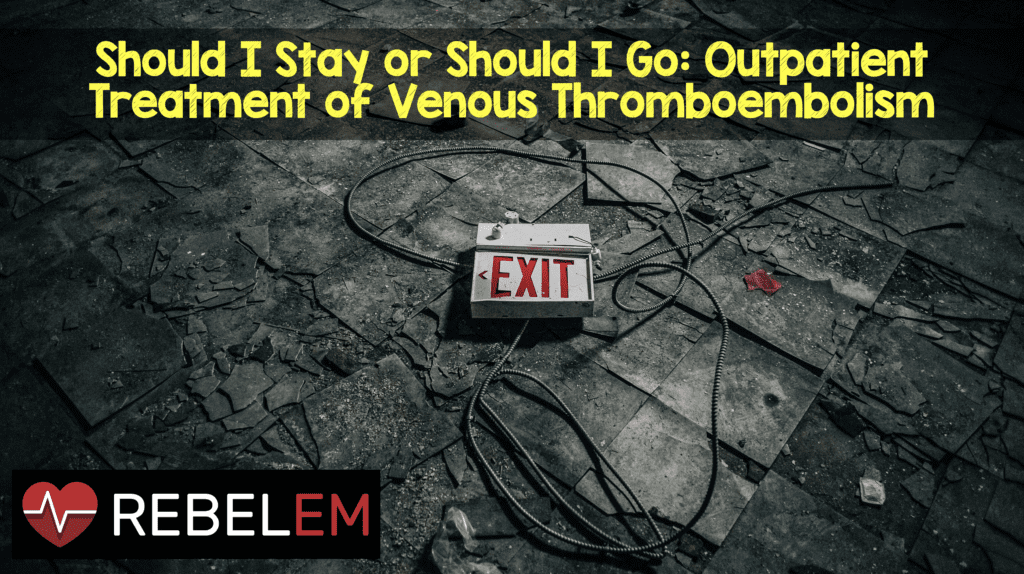

What They Did:
- Development of a Rivaroxaban based protocol to predict which patients are safe for outpatient treatment, diagnosed with DVT or PE
- 1mg/kg Enoxaparin SQ and one 15mg rivaroxaban dose by mouth prior to discharge
- Patients then took 15mg PO BID for 21 days followed by 20mg PO QD of Rivaroxaban until therapy completed
- Prospective observational study at two US hospitals
Outcomes:
- Acceptable outcomes were defined as:
- Venous thromboembolism (VTE) recurrence ≤2.1%
- Bleeding ≤9.4%
- A pooled analysis of the EINSTEIN DVT and PE trials was used to determine these numbers
Definitions:
- Major bleeding: >2g/dL acute drop in hemoglobin or >2-unit blood transfusion, bleeding in a critical area, or bleeding that contributed to death
- Clinically Relevant Non-Major Bleeding: Bleeding that requires the patient to make an unscheduled visit to any health care provider for evaluation, permanently discontinue rivaroxaban, or significantly alter activities of daily living for more than a few days
Inclusion:
- Low Risk patients were identified using a Modified Hestia Criteria and the POMPE-C tool in patients with active malignancy
Modified Hestia Exclusion Criteria:
- Systolic Hypotension (<100mmHg in absence of history of low blood pressure at baseline)
- Contraindication to low-molecular-weight heparin or warfarin treatment (active bleeding or high-risk postoperative status, creatinine clearance <30mL/min, history of heparin-induced thrombocytopenia, or warfarin skin necrosis)
- Other medical condition requiring hospital treatment (sepsis, new or decompensated existing organ failure, intractable pain)
- Social condition requiring hospital treatment (homelessness with history of nonadherence to treatment, suspected neglect or abuse, untreated psychosis, severe alcohol or drug dependency)
- Coagulopathy (any INR >1.7) or thrombocytopenia (platelet count < 50 x109/L)
- Pregnancy
- Incarceration
POMPE-C Exclusion Criteria (Calculator Located HERE):
- Patient Weight (lbs)
- Highest respiratory rate (breaths per min)
- SaO2 (%)
- Heart rate >99 beats/min
- Altered mental status
- Respiratory distress
- Do not resuscitate status
- Unilateral limb swelling
Results:
- 106 patients treated
- 71 (68%) with DVT
- 30 (28%) with PE
- 5 (3%) with both
- 0 Cases of VTE Recurrence (95% CI 0 – 3.4%)
- 0 Cases of major or clinically relevant bleeding
- 3 patients (2.8%) had recurrent DVT after cessation of therapy
Strengths:
- 50% of the patients in this study were self-pay which is more realistic of practice in the US
Limitations:
- Selection bias: only 27% of diagnosed PEs and 51% of diagnosed DVTs were discharged from the ED on rivaroxaban
- 25% of patients did not follow up in clinic
- No comparator group (only historical comparison)
- No cost analysis of this protocol vs standard protocol
Discussion:
- Patients deemed to be low risk were given 1mg/kg enoxaparin and one 15mg rivaroxaban tablet prior to discharge. Enoxaparin was given for two reasons:
- 73% of patients in the EINSTEIN trials received heparin prior to receiving rivaroxaban
- For this protocol enoxaparin was stocked in the ED, but rivaroxaban had to be ordered from the pharmacy causing delays in treatment
- Initial treatment with rivaroxaban is 15mg PO BID for 21 days, followed by 20mg PO once a day for the duration of treatment (3 – 6 months)
- Patients were only given 1 month worth of prescriptions for rivaroxaban, with the rest of the prescription being written at clinic follow up
- Low income, uninsured patients were offered a free of charge or discounted rate for up to 1 year (jjpaf.org)
- Follow up:
- 1 – 2 days after discharge patient called to confirm ability to fill prescription and to answer questions
- 1st follow-up appointment occurred approximately 3 weeks after diagnosis
- 2nd follow up appointment at 3 – 6 months after diagnosis
Author Conclusion: “Patients diagnosed with VTE and immediately discharged from the ED while treated with rivaroxaban had a low rate of VTE recurrence and bleeding.”
Clinical Take Home Point: This is a nice proof of concept publication that further adds to the evidence for the safety of outpatient treatment of low risk DVT and PE in patients with very low complication rates.
References:
- Beam DM et al. Immediate Discharge and Home Treatment With Rivaroxaban of Low-Risk Venous Thromboembolism Diagnosed in Two U.S. Emergency Departments: A One-Year Preplanned Analysis. Acad Emerg Med 2015; 22 (7): 788 – 95. PMID: 26113241
For More Thoughts on This Topic Checkout:
- Ken Milne at The SGEM: SGEM #126 – Take me to the Rivaroxaban – Outpatient Treatment of VTE
Post Peer Reviewed By: Anand Swaminathan (Twitter: @EMSwami)
The post Should I Stay or Should I Go: Outpatient Treatment of Venous Thromboembolism appeared first on REBEL EM - Emergency Medicine Blog.
